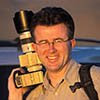http://atrium.andesamazon.org/ - this technology platform is sponsored by Gordon and Betty Moore. If you've ever heard of Moore's Law - this is the guy who came up with it. He's also a big believer in maintaining biodiversity on planet Earth. It's nice to have smart friends who also have money and are willing to put it to good use. Check out the amazing work that is being done in the Amazon basin at http://www.andesamazon.org/. The field researchers are actually uploading data on a real time basis via satellite feed, allowing the data to be ingested and shared with scientists all over the world who can collaborate with the people on the ground. It's truly an amazing technological feat.
Another cool site which contains a lot of digital resources is from the American Museum Congo Expedition 1909-1915 at http://diglib1.amnh.org/. Just for fun, go to Advanced Search and enter monkey in the description field and search. Just to the right of the Red colobus monkey look for the View Related Field Notes link and click that. Now click on View Field Note and you can see the original hand-written notebooks of these scientists. Okay, a little too many clicks to get to what you want, but it still is a fascinating site. There's lots to explore and some of the content is organized into pre-set Galleries to get you started. I found it really interesting stuff.
Another interesting development is in the area of specialized Content Management Systems for sharing biodiversity information. We had a presentation from a Dutch company that is developing these for use worldwide. These "Bioportals" are based on simplenews CMS, which is called a lightweight CMS. See an example of it at http://www.nlbif.nl/. There is another site, which is down at this time for Tanzania at http://www.tanbif.or.tz/. The site is frequently unavailable, at least from my sporadic and slow connection in Nairobi of late. The promise of sharing information over the internet is real, but for much of the developing world, there is also a pressing need for basic infrastructure to support such exchange. It's going to be a while before the whole world can even access the internet reliably, which will make these kinds of sites dependable resources for research.
Since we have been discussing digital repositories, take a look at what's happening at data basin http://www.databasin.org/. It's a repository of spacial information that also has tools for the use of the data and facilitates a network of scientists and practitioners. There are dataset areas on the site that have been focused on Climate, Boreal Forests, Aquatic and Protected Areas. It seems to be based on some kind of CMS, but I'm not sure which. It does have a lot of interesting content and I found it quite engaging even as a non-biologist.
This week we spent a lot of time with Geographic Information Systems. It's a fascinating area and we had the good fortune to have a U of A PhD candidate named John Donoghue to walk us through the basics of GIS. Today, he even had us working with climate change data for the year 2080 and seeing how it would affect certain species. I did mine on pan troglodytes, the chimpanzee. I could see how the chimp's habitat was projected to change in the next 70 years by using graphics in the Q GIS program and MaxEnt. I feel pretty enthused to have even a rudimentary command of the tools needed to do this. I hope the Workshop will help move us toward a more sustainable environment for the chimp, as our nearest relative. Maybe I should do a projection on the species homo sapiens next time.





